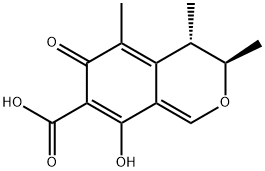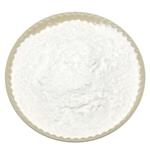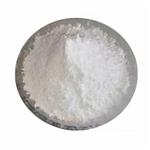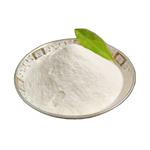Citrinin is a mycotoxin that has been found in Monascus and has diverse biological activities. It is active against S. aureus, methicillin-resistant S. aureus (MRSA), rifampicin-resistant S. aureus, and vancomycin-resistant E. faecium (MICs = 1.95, 3.9, 0.97, and 7.81 μg/ml, respectively), as well as the pathogenic yeast C. neoformans (MIC = 3.9 μg/ml). It is cytotoxic to a variety of cells in vitro, including bovine kidney cells and mice embryonic stem cells. Citrinin (30 μM) induces reactive oxygen species (ROS) production, mitochondrial membrane potential loss, and apoptosis in HepG2 cells, effects that can be blocked by the antioxidant resveratrol. In contrast, citrinin reduces glutamate-induced excitotoxicity in primary rat cortical neurons at concentrations ranging from 0.1 to 1,000 nM and inhibits LPS-induced production of nitric oxide (NO) in RAW 264.7 cells at 0.625 to 40 μM. It is toxic to brine shrimp larvae (LD50 = 96 μg/ml), as well as to rats and mice with oral LD50 values of 50 and 87-105 mg/kg, respectively. It induces reproductive abnormalities in male mice and toxic effects in the liver, kidney, heart, and gastrointestinal tracts of various animals. Citrinin has been found in stored cereal grains, as well as beans, fruit, and herbs.
yellow crystalline powder or flakes
Antimycin (A3C26H36N2O9) and (Antimycin
A1) C28H40N2O9 are crystalline solids.
Antibiotic substance produced by a white spore aspergilus which has been placed under the species name Aspergillus niveus. Also produced in small quantities by Penicillium citrinum.
Citrinin is a quinonemethine mycotoxin produced by diverse fungi including Aspergillus and Penicillium. Citrinin has been extensively investigate, and is a potent nephrotoxin with hepatoxic and teratogenic activity. Citrinin is the causative agent of Balkan nephropathy and yellow rice fever in humans. At the molecular level, citrinin exhibits a range of effects including free radical damage to DNA and disruption of mitochondrial membrane-bound enzymic activities and structural integrity. Specifically, citrinin is an inhibitor of NADH dehydrogenase in the mitochondrial electron transport chain and this action is responsible for recent reports of citrinin's apoptotic activity.
ChEBI: (-)-citrinin is a citrinin. It has a role as a Penicillium metabolite. It is an enantiomer of a (+)-citrinin.
Citrinin is a hepato-nephrotoxic mycotoxin. It can be produced by several filamentous fungi genera of Monauscus, Aspergillus, and Penicillium, which is commonly found as a contaminant in stored grains, foods, feedstuffs and also in biological fluids.
Specific uses for antimycin A were
not found, however, antimycin A1, and antimycin A3 are
reported to be antibiotic substances produced by streptomyces
for use as a fungicide, possible insecticide and miticide.
Registered as a pesticide in the U.S.
previous study found that exposure of hek293 cells to citrinin led to an arrest of cell cycle g2/m in a concentration-dependent increase. citrinin treatment could also elevate the expression levels of p53 and p21 proteins, yet attenuate the signals of phosphorylated cell division cycle 2. moreover, treating hek293 with citrinin could increase both the value of mitotic index and the population of cells, indicating that arrest of citrinin -induced cell cycle occurred mainly during the mitotic phase [1].
previous study showed that citrinin acted as a nephrotoxin in all tested animal species, but its acute toxicity varied in different species. the 50% lethal dose for ducks is 57 mg/kg; for chickens it is 95 mg/kg; and for rabbits it is 134 mg/kg. in murine kidneys, citrinin could also synergistically act with ochratoxin a to depress rna synthesis [2].
UN2811 Toxic solids, organic, n.o.s., Hazard
Class: 6.1; Labels: 6.1-Poisonous materials, Technical
Name Required.
[1] chang ch, yu fy, wu ts, wang lt, liu bh. mycotoxin citrinin induced cell cycle g2/m arrest and numerical chromosomal aberration associated with disruption of microtubule formation in human cells. toxicol sci. 2011 jan;119(1):84-92.
[2] j. w. bennett and m. klich. mycotoxins. clin.microbiol.rev. 16(3), 497-516 (2003).



